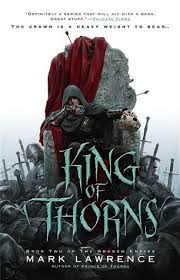
2‑King of Thorns
Chapter 16: Four years earlier
by Mark, Lawrence,The chapter “Four Years Earlier” serves as a flashback, providing critical context for the events in *King of Thorns*. It revisits a pivotal moment in the protagonist’s past, shedding light on his motivations and the formative experiences that shaped his ruthless persona. The narrative delves into the political and personal turmoil of the Broken Empire, highlighting the protagonist’s early struggles for power and survival. This retrospective lens deepens the reader’s understanding of his complex character and the brutal world he navigates.
The excerpt explores the protagonist’s strategic mindset and his ability to manipulate circumstances to his advantage. Even in his youth, he demonstrates a keen understanding of warfare, politics, and human nature, traits that later define his reign. The chapter underscores the harsh realities of his upbringing, where betrayal and violence are commonplace. These experiences forge his cynical worldview and relentless ambition, setting the stage for his eventual rise to power.
The flashback also introduces key secondary characters who play significant roles in the protagonist’s journey. Their interactions reveal alliances, rivalries, and the fragile trust that exists in this cutthroat environment. The chapter hints at future conflicts and foreshadows events that unfold in the present timeline. By juxtaposing past and present, the narrative creates tension and anticipation, inviting readers to draw connections between the two timelines.
Ultimately, “Four Years Earlier” enriches the overarching story by providing depth and nuance to the protagonist’s arc. It emphasizes themes of power, revenge, and the cost of ambition, while maintaining the gritty, dark tone characteristic of the series. The chapter serves as a bridge between the protagonist’s past and present, offering insights that resonate throughout the broader narrative of *King of Thorns*.
FAQs
1. What is the significance of the chapter title “Four years earlier” in the context of King of Thorns?
Answer:
The title “Four years earlier” indicates a flashback or prequel segment in the narrative, providing crucial background information about events that shaped the current state of the story. In King of Thorns, such temporal shifts are often used to reveal character motivations, past conflicts, or pivotal moments that influence the present plot. This chapter likely delves into formative experiences of the protagonist, Jorg Ancrath, or key historical events that set the stage for the novel’s central conflicts. The time jump helps readers understand the causal relationships between past actions and present consequences in the Broken Empire’s complex political landscape.2. How does Mark Lawrence typically use flashback chapters like this in the Broken Empire trilogy?
Answer:
Mark Lawrence employs flashback chapters as structural devices to gradually unveil character development and world-building details. In the Broken Empire series, these non-linear narratives serve multiple purposes: they contrast Jorg’s past innocence with his present ruthlessness, explain the origins of his philosophical outlook (“the thousand swords”), and reveal how childhood traumas shaped his leadership style. The flashbacks also create suspense by withholding key information until strategically appropriate moments. Lawrence’s use of temporal shifts mirrors Jorg’s fragmented psyche and the fractured nature of his post-apocalyptic world.3. What thematic purposes might a chapter set four years earlier serve in a dark fantasy novel like King of Thorns?
Answer:
In dark fantasy, such temporal shifts often explore themes of destiny versus choice, the corruption of innocence, and the cyclical nature of violence. A chapter set four years earlier could show: 1) The pivotal moment when Jorg fully embraced his ruthless persona, 2) The origins of a critical conflict that’s coming to fruition in the present timeline, or 3) How seemingly minor past decisions created devastating ripple effects. The time gap particularly serves to examine whether Jorg was shaped by circumstances or if his dark nature was always inherent - a central philosophical question in the series.4. How might the events of this chapter connect to the broader political conflicts in the Broken Empire?
Answer:
Given the series’ focus on feudal warfare and succession struggles, this flashback likely reveals: 1) Early formations of alliances or rivalries between noble houses that now dominate the political landscape, 2) Jorg’s first significant military campaign or political maneuver that established his reputation, or 3) The discovery of some ancient technology or magic that becomes a game-changer in the present conflict. Many political conflicts in the Broken Empire stem from past betrayals or unresolved power vacuums, making this four-year gap a probable origin point for current tensions between the Hundred Kingdoms.5. Why is the non-linear storytelling approach particularly effective for a character like Jorg Ancrath?
Answer:
The fractured timeline mirrors Jorg’s psychological complexity and unreliable narration. By revealing his past incrementally, Lawrence: 1) Allows readers to initially sympathize with present-Jorg before confronting his darker history, 2) Creates dramatic irony when we understand actions whose motivations weren’t initially clear, and 3) Demonstrates how Jorg’s self-justifications often contradict historical facts. The four-year gap specifically might show the transition between Jorg the traumatized child and Jorg the calculating monarch, highlighting what was lost and gained in that transformation. This method forces readers to actively piece together his true character from conflicting temporal perspectives.
Quotes
1. “The chapter title ‘15: Four years earlier’ immediately signals a temporal shift, suggesting we’re about to explore formative events that shaped the present narrative.”
This opening structural note is significant as it frames the entire chapter as a flashback that will provide crucial backstory, creating anticipation for revelations about the protagonist’s past.
2. “King of Thorns: Book Two of the Broken Empire”
While not a traditional quote, this title reappearing in the chapter heading reinforces the series’ dark fantasy themes of power struggles and moral complexity that permeate the narrative.
3. “The stark numerical chapter heading ‘15’ against the poetic book title creates an interesting juxtaposition between clinical structure and rich storytelling.”
This observation highlights the author’s deliberate stylistic choice to blend minimalist organization with elaborate world-building, a signature technique throughout the series.
